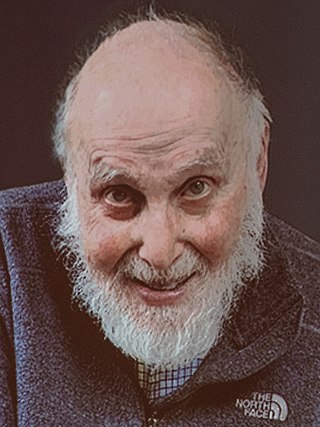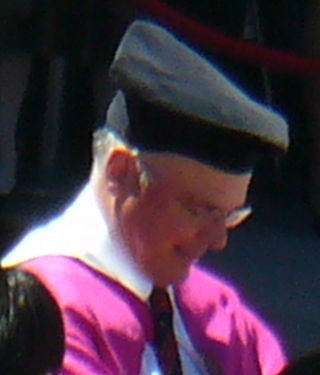Related Research Articles

Nokia Bell Labs, originally named Bell Telephone Laboratories (1925–1984), then AT&T Bell Laboratories (1984–1996) and Bell Labs Innovations (1996–2007), is an American industrial research and scientific development company owned by Finnish company Nokia. It is headquartered in Murray Hill, New Jersey, and operates a global network of laboratories.

Optical tweezers are scientific instruments that use a highly focused laser beam to hold and move microscopic and sub-microscopic objects like atoms, nanoparticles and droplets, in a manner similar to tweezers. If the object is held in air or vacuum without additional support, it can be called optical levitation.
Calvin Forrest Quate was one of the inventors of the atomic force microscope. He was a professor emeritus of Applied Physics and Electrical Engineering at Stanford University.
Albert Vinicio Báez was a Mexican-American physicist and the father of singers Joan Baez and Mimi Fariña, and an uncle of John C. Baez. He made important contributions to the early development of X-ray microscopes, X-ray optics, and later X-ray telescopes.

Arthur Ashkin was an American scientist and Nobel laureate who worked at Bell Laboratories and Lucent Technologies. Ashkin has been considered by many as the father of optical tweezers, for which he was awarded the Nobel Prize in Physics 2018 at age 96, becoming the oldest Nobel laureate until 2019 when John B. Goodenough was awarded at 97. He resided in Rumson, New Jersey.

Steven Chu is an American physicist and former government official. He is a Nobel laureate and was the 12th U.S. secretary of energy. He is currently the William R. Kenan Jr. Professor of Physics and Professor of Molecular and Cellular Physiology at Stanford University. He is known for his research at the University of California, Berkeley, and his research at Bell Laboratories and Stanford University regarding the cooling and trapping of atoms with laser light, for which he shared the 1997 Nobel Prize in Physics with Claude Cohen-Tannoudji and William Daniel Phillips.

Narinder Singh Kapany was an Indian-American physicist best known for his work on fiber optics. Kapany is a pioneer in the field of fiber optics, and known for coining and popularising the term. Fortune named him one of seven 'Unsung Heroes of the 20th century' for his Nobel Prize-deserving invention. He was awarded India's second highest civilian award the Padma Vibhushan posthumously in 2021. He served as an Indian Ordnance Factories Service (IOFS) officer. He was also offered the post of Scientific Adviser to the Defence Minister of India, by the first Prime Minister of India, Jawaharlal Nehru.

Robert Louis Byer is a physicist. He was president of the Optical Society of America in 1994 and of the American Physical Society in 2012.
Rod C. Alferness was president of The Optical Society in 2008.

Anthony Michael Johnson is an American experimental physicist, a professor of physics, and a professor of computer science and electrical engineering at the University of Maryland, Baltimore County (UMBC). He is the director of the Center for Advanced Studies in Photonics Research (CASPR), also situated on campus at UMBC. Since his election to the 2002 term as president of the Optical Society, formerly the Optical Society of America, Johnson has the distinction of being the first and only African-American president to date. Johnson's research interests include the ultrafast photophysics and nonlinear optical properties of bulk, nanostructured, and quantum well semiconductor structures, ultrashort pulse propagation in fibers and high-speed lightwave systems. His research has helped to better understand processes that occur in ultrafast time frames of 1 quadrillionth of a second. Ultrashort pulses of light have been used to address technical and logistical challenges in medicine, telecommunications, homeland security, and have many other applications that enhance contemporary life.

Benjamin John Eggleton,, is Pro Vice Chancellor (Research) at the University of Sydney. He is also Professor in the School of Physics where he leads a research group in photonics, nanotechnology and smart sensors and serves as co-director of the NSW Smart Sensing Network (NSSN).
Hyatt M. Gibbs was a notable physicist and professor at the University of Arizona College of Optical Sciences. Well known for research in nonlinear optics and quantum optics, he authored a book on optical bistability, and was a recipient of the Humboldt Research Award and Michelson Medal.

Philip H. Bucksbaum is an American atomic physicist, the Marguerite Blake Wilbur Professor in Natural Science in the Departments of Physics, Applied Physics, and Photon Science at Stanford University and the SLAC National Accelerator Laboratory. He also directs the Stanford PULSE Institute.
Liu Gang is a Chinese-born American aerospace engineer, computer scientist, optical physicist, political activist, and writer. He founded the Beijing Students' Autonomous Federation. He was a prominent student leader at the Tiananmen Square protests of 1989. Liu holds a M.A. in physics from Peking University and a M.A. in computer science from Columbia University. After his exile to the United States in 1996, Liu studied technology and physics at Bell Labs in New Jersey. Liu was employed at Morgan Stanley as a Wall Street IT analyst.

Robert Eric Betzig is an American physicist who works as a professor of physics and professor of molecular and cell biology at the University of California, Berkeley. He is also a senior fellow at the Janelia Farm Research Campus in Ashburn, Virginia.
Thorlabs, Inc. is an American privately held optical equipment company headquartered in Newton, New Jersey. The company was founded in 1989 by Alex Cable, who serves as its current president and CEO. As of 2018, Thorlabs has annual sales of approximately $500 million. Outside its multiple locations in the United States, the company has offices in Brazil, Canada, China, France, Germany, Japan, Sweden, and the United Kingdom. It sells approximately 20,000 different products.
Ernst Leitz GmbH was a German corporation based in Wetzlar, a German centre for optics as well as an important location for the precision engineering industry.

David A. B. Miller is the W. M. Keck Foundation Professor of Electrical Engineering at Stanford University, where he is also a professor of Applied Physics by courtesy. His research interests include the use of optics in switching, interconnection, communications, computing, and sensing systems, physics and applications of quantum well optics and optoelectronics, and fundamental features and limits for optics and nanophotonics in communications and information processing.
Linn Frederick Mollenauer (1937–2021) was an American physicist who worked on quantum optics, including the study of solitons in fiber optics.
Gordon Stanley Kino was an Australian-British-American inventor and professor of electrical engineering and applied physics. He is known for "inventing new microscopes that improved semiconductor manufacturing and transformed medical diagnostics." His dual-axis confocal microscope has several advantages over the single-axis confocal microscope.
References
- ↑ "Thorlabs - Your Source for Fiber Optics, Laser Diodes, Optical Instrumentation and Polarization Measurement & Control". www.thorlabs.com. Retrieved 2020-02-04.
- 1 2 3 4 Kathy Stevens (October 4, 2010). "Thorlabs breaks ground in Newton". The New Jersey Herald. Archived from the original on March 9, 2015. Retrieved March 4, 2014.
- 1 2 3 4 5 6 7 8 Laurie Gordon (September 30, 2013). "Focus on fitness at the core of Thor Labs". The Sparta Independent. Retrieved February 23, 2015.
- 1 2 3 4 5 6 "CATS Industrial Advisory Board". Center for Automation Technologies and Systems. Archived from the original on February 27, 2015. Retrieved February 26, 2014.
- 1 2 3 4 5 6 7 8 9 Oliver Graydon (June 18, 2004). "European acquisitions fuel appetite for growth". Optics.org. Retrieved February 24, 2015.
- 1 2 3 4 5 6 7 8 Alex Cable. "Introducing Thorlabs" (PDF). Thorlabs catalog. Retrieved March 6, 2015.
- 1 2 Steven Chu (July 1, 1998). "Nobel Lecture: The manipulation of neutral particles". Reviews of Modern Physics. 709 (3): 685–706. Bibcode:1998RvMP...70..685C. doi: 10.1103/RevModPhys.70.685 .
- 1 2 "StackPath". www.laserfocusworld.com. 13 June 2016. Retrieved 2020-05-28.
- ↑ Gale Business Insights (Report). Gale. 2015. Document #565502.
- ↑ "Alex Cable profile". Bloomberg. Retrieved February 26, 2015.
- 1 2 "Alex Cable citation report". Google Scholar. Retrieved February 23, 2015.
- 1 2 Martin Blume; Stanley Brown (12 February 2014). "Letters from the Past – A PRL Retrospective". Physical Review Letters. Retrieved February 24, 2015.